What is this curlicue ice coming out of the ground?
Things that make winter just a little more fun
Recently, during the last polar vortex in January, I took a walk with Toby along a lake near our house. The temperatures were cold for Georgia – even at midday, the air hovered around 31 degrees F with frozen plate ice hugging the shallows at the water’s edge. Our breaths – Toby’s and mine – puffed as we meandered among the trees, the chill air silencing even the birds so that we seemed to be the only living things among the dried stalks and frozen earth.
But then I noticed something white glistening on the ground. I wasn’t sure if it was simply a piece of fisherman’s trash, but when I bent down, I saw a ribbon of ice curled among the leaves. Glancing around, I began to see other clusters alongside the path:
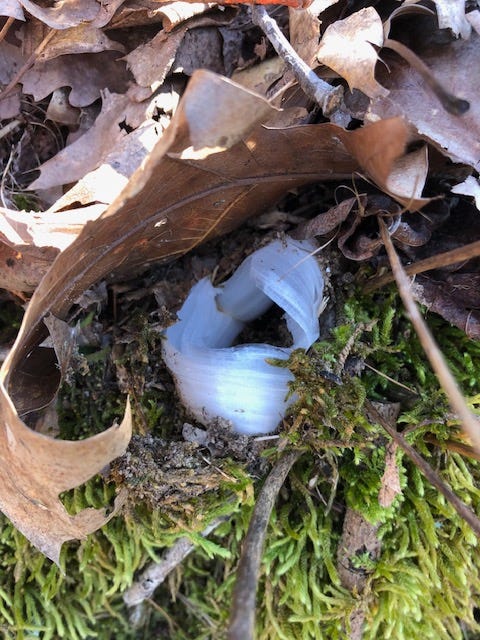
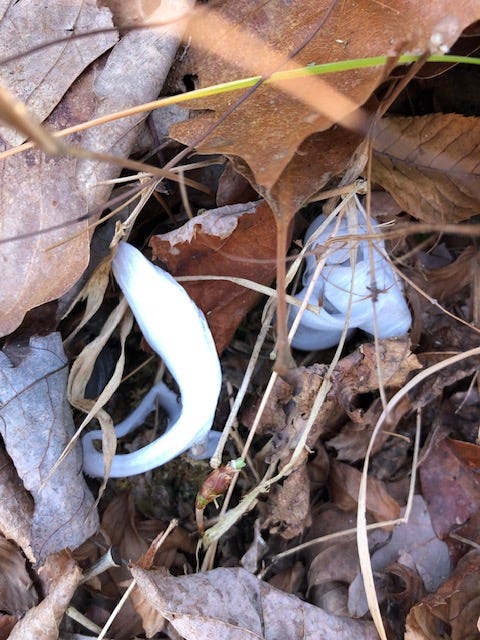
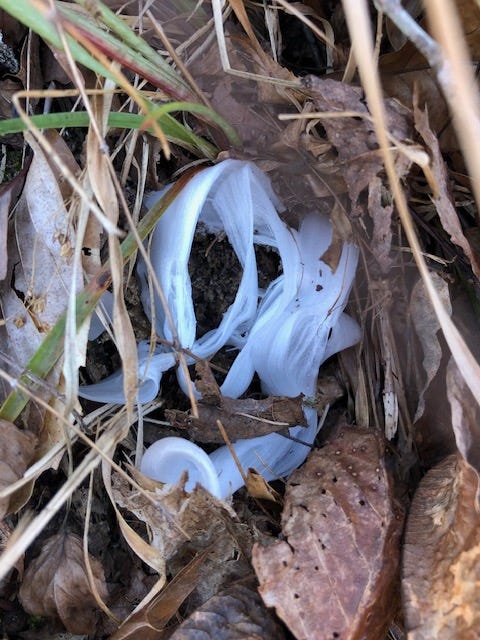

They were obviously made of ice, but it didn’t look like the normal freeze-thaw ice that typically pushes its way up through softer ground.
What is this curlicue ice coming out of the ground?
I had to wait to get home before researching these odd ice formations, but once I did, I regretted not having combed the woods for more. It turns out these are called “frost flowers,” though they go by many other names: rabbit ice, ice fringes, ice ribbons, and ice filaments. However, “ice flowers” is probably the most accurate name for them because they have nothing to do with frost.
Ice flowers form when the outside air temperature is just below freezing but the ground is not frozen. Water rises through plant stems via capillary action and seeps out of cracks in the stalks. As it hits the air, it freezes. That crystallization creates just enough heat to allow the water in the stem to remain liquid and continue to push outward, creating ribbons of ice that form into delicate, icy sculptures:
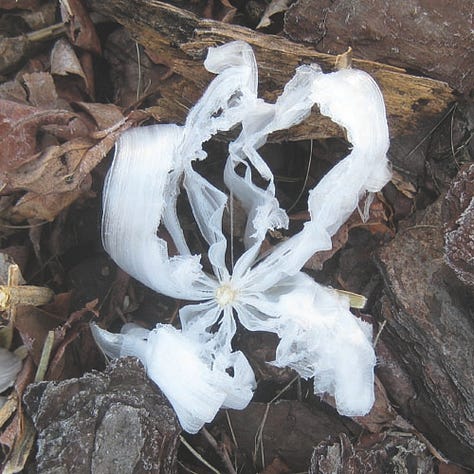


The ice flowers form even though the stalks from which they emerge are dried and dead looking. That’s because the liquid is not coming from the plant itself, but is being sucked up from the unfrozen ground below, essentially like a straw with a split in the side. Look in many of the pictures above and you can see the dried stems in the midst of the flower.
This is a short time lapse video of ice flowers forming:
This is why I really wish I’d gone hunting for more of these while I had the chance – they’re extremely rare and each one is uniquely shaped as it emerges from a dried-up plant stalk. I wish I’d paid more attention to those central stalks in each sculpture.
Frost flowers don’t form out of just any plant. There are around 40 different species of plants with non-woody stems that can create them, among them crownbeard, yellow ironweed, and dittany. You might choose to emulate James Richard Carter, who successfully transplanted specimens of these plants to his own yard after stumbling across their ice flowers one winter. He was then able to grow ice flowers in his backyard for years to come.
Another icy art form is “hair ice,” which I thought might be the source of my ice sculptures before I researched further. Hair ice, however, only forms on wet wood rather than plant stems. It results in extremely fine ice crystals, each filament measuring a diameter of about 0.02 mm (0.0008 in):

The unusual thing about hair ice? It grows only out of the fungus Exidiopsis effusa in dead wood. Scientists aren’t sure about how it exactly forms from the fungus, but speculate that a sort of antifreeze prevents the tiny hairs of ice from recrystallizing into larger ones. Weather conditions must be identical to ice flowers as well – air temperatures just below freezing while the water inside the dead wood remains in a liquid state.
And then there’s needle ice, which is much more common. It occurs under the same conditions (air is just below freezing, groundwater is liquid), when capillary action draws water upward to the surface and freezes it in small ice towers:

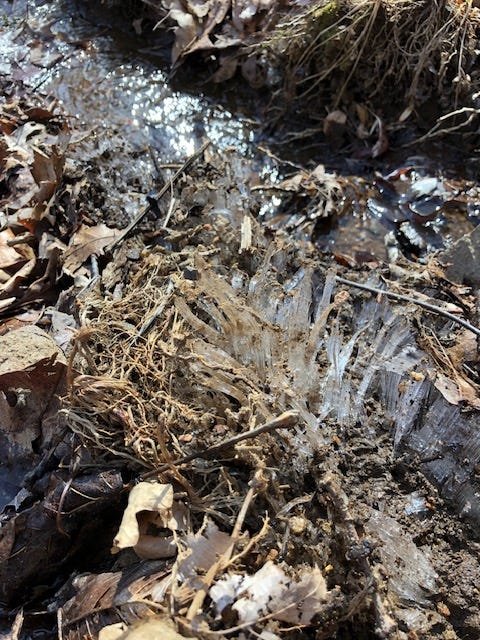
It tends to happen in porous soil where groundwater is plentiful, oftentimes near creekbanks or around tree stumps. As the ice needles push upward, they take the soil with them and thus can contribute to the displacement of small seedlings and erosion and even upheaval of rocks.
As a matter of fact, needle ice can also indirectly cause the odd phenomenon pictured below, when several trees are similarly curved on a bank:
This simultaneous curvature of the trees is due to soil creep, where the bank has slowly been slipping downwards for years. The movement is slow enough to allow the younger, more supple trees to compensate as they curve upward towards the sun. The freeze-thaw and upheaval of soil due to needle ice is one of the possible causes of this soil creep phenomena. Creepy!
Now that I know the conditions needed for these unusual icy formations, I’m finding myself hoping for at least one more deep freeze that would allow me to scout them out this winter. Next time it’s icy-cold in your area, slip outside and peek amongst the leaves – perhaps you’ll find some ice sculptures of your own!
Weird Nature:
Click to watch this:





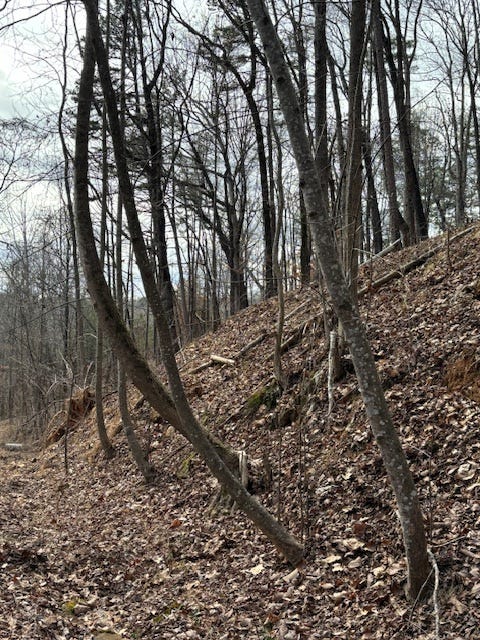

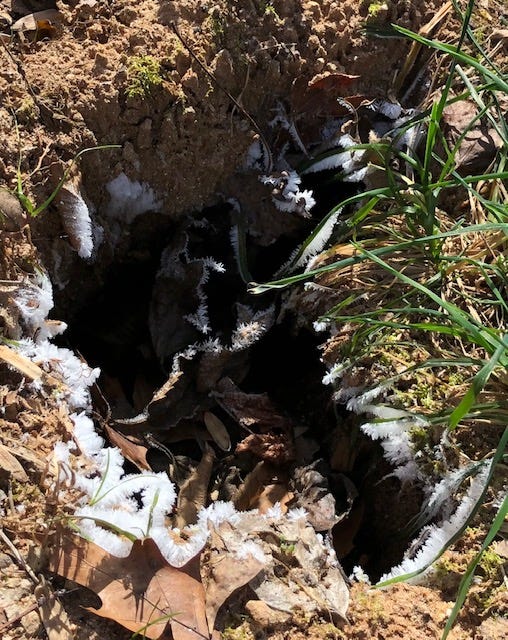
Heather this is absolutely fascinating! Kind of like the aurora borealis... right conditions, right time.
That is so cool. Sadly not a delight I'm likely to encounter here (only complaining very slightly because I don't like really cold weather).